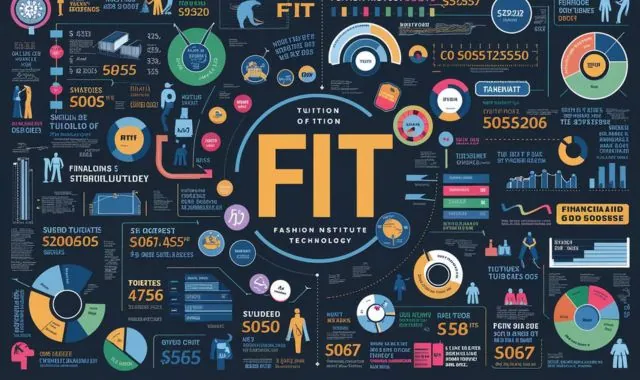Physical Address
304 North Cardinal St.
Dorchester Center, MA 02124
Physical Address
304 North Cardinal St.
Dorchester Center, MA 02124

This article explores the cost of attending the Fashion Institute of Technology Tuition . It details how tuition varies by residency and program type, and explores additional expenses like housing and supplies. Financial aid options like scholarships and work-study are explained, along with tips to manage FIT tuition costs. Ultimately, the article helps you decide if the investment in a FIT education is worth it for your fashion design dreams.

Turning your passion for fashion into a career can be incredibly rewarding, but the cost of education can be a major hurdle. The Fashion Institute of Technology (FIT) is a renowned institution for aspiring fashion professionals, but how much does it actually cost to turn your design dreams into reality? This article unveils the intricacies of FIT tuition, explores additional expenses, and offers valuable tips to manage the financial burden.
FIT stands out as a premier choice for fashion education. With a rich history and a focus on industry-specific programs, FIT equips you with the skills and knowledge coveted by top fashion houses. From design and textiles to business and marketing, FIT offers a comprehensive curriculum that prepares you to thrive in the competitive fashion world.
FIT tuition varies depending on several factors, so understanding the breakdown is crucial. Here’s a closer look:
Residency status significantly impacts tuition costs. New York City and State residents enjoy considerably lower tuition rates compared to out-of-state and international students.
In-state students pay significantly less per semester. For example, associate degree programs cost roughly $2,645 per semester for in-state students, while out-of-state students pay nearly triple that amount at $7,935. Similar discrepancies exist for bachelor’s degrees.
Tuition also differs based on your chosen program. Associate degrees generally cost less than bachelor’s degrees. Carefully research the specific program you’re interested in to get an accurate estimate.
On top of tuition, consider these additional expenses:
FIT offers on-campus housing with varying costs depending on the type of accommodation and meal plan chosen. Budget for these necessities based on the options you select.
Textbooks, specialized equipment, and design supplies can add up. Factor in these costs when planning your budget.
Transportation to and from campus, as well as any field trips or industry events, should be factored into your financial planning.

FIT offers various financial aid options to help manage the cost of education:
These need-based and merit-based awards can significantly reduce tuition costs. Apply for scholarships early and meet all deadlines to increase your chances of receiving aid.
Work-study programs allow you to earn money on campus to help offset educational expenses.
FIT offers payment plans to spread out tuition payments throughout the semester, making them more manageable.
Here are some strategies to make FIT tuition more manageable:
Research and apply for scholarships offered by FIT, external organizations, and even fashion-related businesses. Starting early significantly boosts your chances of securing financial aid.
If you’re not currently a New York resident, consider establishing residency before enrolling. This can dramatically reduce tuition costs.
Balancing part-time work or a work-study program with your studies can help you earn income to contribute towards educational expenses.
Purchasing used textbooks and supplies can save you a significant amount of money. Explore online marketplaces or inquire with upperclassmen for potential deals.

While FIT tuition represents a substantial investment, consider it an investment in your future fashion career. The skills, knowledge, and network gained at FIT can translate into a rewarding and lucrative career in the fashion industry.
Whether FIT tuition is “worth it” depends on your individual circumstances, financial resources, and career aspirations. Carefully weigh the cost against the potential benefits and return on investment a FIT education offers. Consider reaching out to FIT’s financial aid office for personalized guidance and exploring scholarship opportunities. Remember, a FIT education can be a valuable stepping stone towards achieving your dreams in the world of fashion.
Investing in a fashion education at FIT can be a life-changing decision. By understanding the financial landscape, exploring financial aid options, and implementing cost-saving strategies, you can make your dream of studying at FIT a reality. Remember, the knowledge, skills, and connections gained at FIT are invaluable assets that can propel you towards a successful and fulfilling career in the ever-evolving world of fashion.
A: The average cost of attending FIT varies greatly depending on residency status and program type. In-state students pay significantly less than out-of-state students, and associate degrees generally cost less than bachelor’s degrees. To get a more accurate estimate, visit the FIT tuition and fees page: FIT Tuition and Fees.
A: Yes, FIT offers various financial aid options to help students manage the cost of education. These include scholarships, grants, work-study programs, and payment plans. Explore the FIT financial aid website for more details and application procedures: FIT Financial Aid.
A: Yes, FIT and external organizations offer scholarships specifically for fashion students. Research these opportunities diligently and apply early to increase your chances of receiving aid.
A: There are specific requirements for establishing residency in New York for tuition purposes. Consult the FIT admissions office or relevant state agencies for detailed information on residency requirements.
A: Consider purchasing used textbooks and supplies online or from upperclassmen. Renting textbooks can also be an option. Utilize the FIT library resources and explore free online learning materials whenever possible.